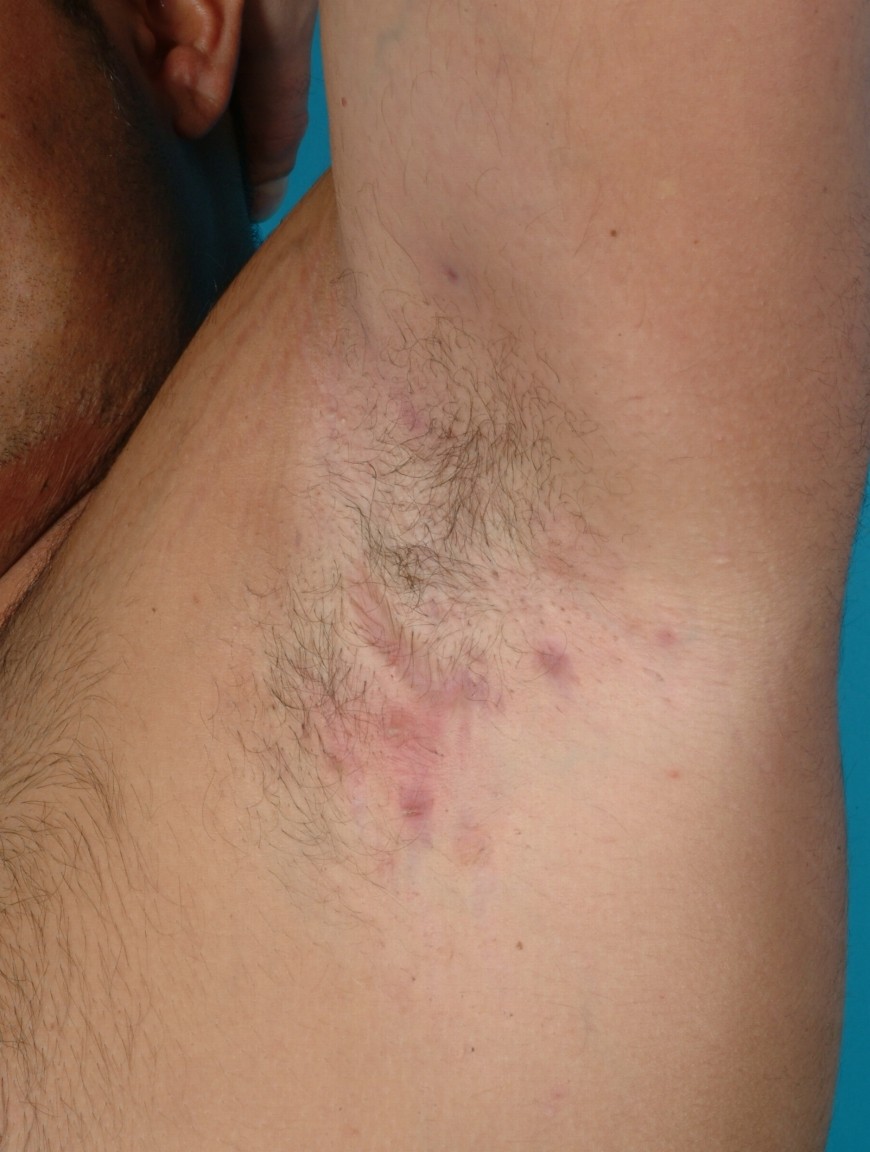Playlist
Show Playlist
Hide Playlist
Derma Case: 24-year-old Woman with Chronic Pain in Axillae
-
Slides Disorders of sebaceous and apocrine glands.pdf
-
Reference List Dermatology.pdf
-
Download Lecture Overview
00:01 Alright, let's do one last case to review another important disease that we have not yet mentioned. 00:07 This is a 24-year old obese woman with a past medical history of diabetes, who is now presenting with acute on chronic pain in both axillae. 00:16 She has intermittently had mild discomfort in one or both axilla for months to years, but has noted the development of multiple, inflammed, red, tender bumps over the past few weeks that occasionally rupture and drain. 00:29 No fevers or chills. 00:30 She smokes a pack a day, denies any alcohol or illicit drugs. 00:34 Her mother, interestingly had similar issues herself many years ago. 00:39 Review of systems is negative and on our exam we see multiple, deep, nodular lesions in both axillae that are tender and erythematous. 00:48 There's a 2x3 cm lesion that even expresses some purulent drainage when compressed. 00:53 There is scarring present in her left axilla and a few comodones are noted. 00:58 So let's go through some key features of this case to get us thinking about what the ultimate diagnosis is. 01:03 So I can tell you that this disease that I have not yet identified is more common in women. 01:08 It's also more common in those who are obese and it typically has an onset in late adolescence. 01:13 The fact that we have symmetric symptoms is also characteristic. 01:17 Usually the axilla is involved, occassionally patients will also have lesions in the anogenital region. 01:23 The family history is also important. 01:25 Oftentimes, patients will report that their mother or an aunt or some other family member had this disease but that it spontaneously resolved as that significant other or family member got older. 01:38 So this diagnosis is hidradenitis suppurativa. 01:41 This is a chronic suppurative disease of the apocrine glands and since apocrine glands - that is sweat glands, are most often occuring in the axilla and the groin, that's why the disease there is most abundant. 01:54 What's happening is follicular occlusion, followed by follicle rupture which leads to an immune response and ultimately a superimposed bacterial infection because of the disruption of the body's natural immunity around hair follicles. 02:08 The treatment is gonna be weight loss, there's evidence that smoking cessation can also help and you wanna tell patients to avoid shaving in the area cause that's just gonna exacerbate the location of the disease. 02:19 Using gentle soaps can be helpful. 02:22 For significant disease, we can use intralesional corticosteroirds, oftentimes topical or occasionally systemic antibiotics and oftentimes you need refer this patient to a surgeon for surgical incision and drainage when necessary if there's a large collection. 02:36 Lastly, under extenuating circumstances, we may use systemic corticosteroids,TNF-alpha inhibitors or potentially isotretinoin which we've talked about before with the treatment of acne vulgaris.
About the Lecture
The lecture Derma Case: 24-year-old Woman with Chronic Pain in Axillae by Stephen Holt, MD, MS is from the course Miscellaneous Skin Disorders.
Included Quiz Questions
Which of the following is associated with hidradenitis suppurativa?
- Bilateral lesions in the axillae
- Onset at age > 35 years
- More common in men
- Moderate to severe disease is managed with topical retinoids
- A chronic, suppurative disease of the sebaceous glands
Customer reviews
5,0 of 5 stars
| 5 Stars |
|
5 |
| 4 Stars |
|
0 |
| 3 Stars |
|
0 |
| 2 Stars |
|
0 |
| 1 Star |
|
0 |




